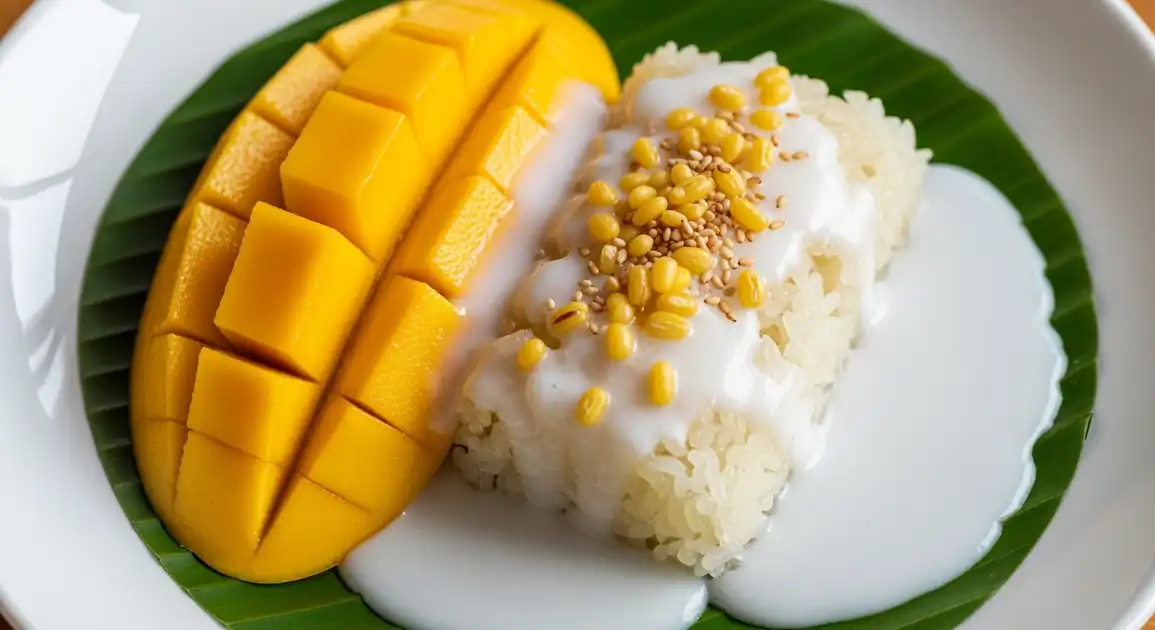Mango Sticky Rice
ข้าวเหนียวมะม่วง (Khao Niao Mamuang)

Description
Mango Sticky Rice is arguably Thailand's most famous dessert, beloved nationwide. It's available in restaurants, markets, and from street vendors, especially prominent during the mango season (March-June). Quality and price vary, but it's a must-try sweet treat.
Dietary Information
Serving information
Serving style
Typically served on a small plate or in a styrofoam/plastic box for takeaway. Consists of sticky rice, sliced mango alongside, topped with coconut cream and garnish. Eaten with a spoon.
Quick facts
Varies greatly. Street vendors often appear from late morning/afternoon into the evening (e.g., 11 AM - 10 PM). Restaurants serve it during lunch and dinner hours.
Safety Tips
What to Look For
-
Ripe, freshly cut mango
Mango should be vibrant yellow/gold, sweet-smelling, and cut upon order or look recently prepared. Avoid brown, mushy, or sour-smelling mango.
-
Fresh-looking sticky rice
Rice should be moist, glossy, and soft. Avoid rice that looks dry, hard, discolored, or has been sitting out uncovered for long periods.
-
Fresh coconut milk/cream
Coconut milk spoils quickly in heat. Look for white, creamy sauce. Avoid anything yellowish, separated, bubbly, or smelling sour, which indicates spoilage.
-
Vendor assembles the dish to order
Ensures maximum freshness, especially for the mango and coconut cream topping. Pre-assembled boxes sitting in the sun are riskier.
-
Clean preparation area and utensils
Look for clean cutting boards, knives, spoons, and containers. Observe hygienic handling practices.
-
Busy stall with high turnover
Indicates that ingredients are likely replenished frequently and haven't been sitting around for too long.
What to avoid
-
Mangoes that look bruised, overly soft, or brownish
These are signs of overripeness or spoilage.
-
Coconut cream that smells sour or looks separated/yellow
Spoiled coconut milk can cause food poisoning. Trust your nose.
-
Pre-packaged portions left sitting in direct sunlight or heat
Heat accelerates spoilage, especially of the coconut milk and mango.
-
Sticky rice that appears dry, hard, or discolored
Indicates it's not fresh or properly prepared.
-
Visible flies or pests around the food display
A clear sign of poor hygiene.
-
Unclean vendor practices (e.g., handling money then food without cleaning hands)
Increases risk of cross-contamination.
Price information
Price range
Budget tips
- Street vendors and local markets generally offer the lowest prices (50-100 THB).
- Restaurant prices are higher, reflecting ambiance and service (100-250+ THB).
- Prices peak slightly outside of mango season due to mango cost.
Value indicators
- Use of premium mango varieties (Nam Dok Mai, Ok Rong).
- Generous portion of fresh, ripe mango.
- Perfectly cooked, fragrant sticky rice.
- Freshly prepared coconut cream.
- Good balance of sweet and slightly salty flavors.
Where to Find This Dish
Night Markets
Widely available at most night markets across Thailand.
Various city night markets
6 PM - 11 PM
Fresh Markets
Often found near fruit stalls or in cooked food sections.
Local 'Talad Sot'
Morning, Daytime
Tourist Areas
Readily available in areas frequented by tourists.
Beach towns, City centers
Daytime, Evening
Vendor Tips
- Look for vendors proudly displaying high-quality mangoes.
- Choose stalls where the components look fresh and are assembled to order.
- Specialty dessert shops often offer premium versions.
How to Order
Regional Variations
-
With Crispy Yellow Mung Beans
(ใส่ถั่วทองทอด (Sai Thua Thong Thot))
Toasted or fried split mung beans are sprinkled on top instead of, or in addition to, sesame seeds, adding a crunchy texture.
-
Different Mango Varieties
(มะม่วงพันธุ์ต่างๆ (Mamuang Phan Tang Tang))
While Nam Dok Mai and Ok Rong are classics, other sweet mango varieties might be used depending on availability and season.
-
Butterfly Pea Sticky Rice
(ข้าวเหนียวอัญชัน (Khao Niao Anchan))
Sticky rice naturally colored blue/purple using butterfly pea flowers, offering a visual variation without significant flavor change.
-
Black Sticky Rice
(ข้าวเหนียวดำ (Khao Niao Dam))
Sometimes made with black glutinous rice, which has a nuttier flavor and firmer texture.
Cultural context
History
Mango Sticky Rice is a traditional Thai dessert with roots possibly dating back to the late Ayutthaya period or early Rattanakosin period. It showcases key Thai ingredients: rice, coconut, and seasonal fruit. It gained immense popularity both domestically and internationally, becoming synonymous with Thai cuisine, especially enjoyed during the hot summer mango season.
Local significance
A quintessential Thai dessert representing the country's abundance of tropical fruit and mastery of balancing sweet, salty, and creamy flavors.
Eating customs
- Best eaten fresh shortly after preparation.
- Mix a bit of mango, rice, and sauce in each spoonful.
- Considered a treat rather than an everyday staple for some.